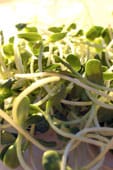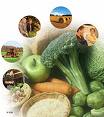Chapman already commented on some of the, uh, failings of the recent top 10 (PR stunt) allegedly most dangerous foods issued by the poorly named Center for Science in the Public Interest – there wasn’t much science or public interest in that last report.
.jpg) The produce industry types responded with the blame-the-consumer routine, which is (incredibly dumb) unfortunate given that many outbreaks involving fresh fruits and vegetables clearly need to be prevented on the farm and have nothing to do with consumers.
The produce industry types responded with the blame-the-consumer routine, which is (incredibly dumb) unfortunate given that many outbreaks involving fresh fruits and vegetables clearly need to be prevented on the farm and have nothing to do with consumers.
“Consumers and other food handlers play a huge role in preventing illnesses, and they do need more information on safe handling.”
Neither approach is helpful. Casey Jacob and I tried to contribute to the public conversation about foodborne illness, where it happens and who’s to blame, with the appropriately titled paper, Where Does Foodborne Illness Happen—in the Home, at Foodservice, or Elsewhere—and Does It Matter? in the journal, Foodborne Pathogens and Disease.
The paper has been published online ahead of print. We conclude,
While some occurrences of foodborne illness result from unsafe practices during final preparation or serving at the site where food was consumed, others are consequences of receiving contaminated food from a supplier, or both. Data gathered on instances of contamination that lead to illness make greater contributions to the development of programs that reduce the risk of foodborne illnesses, than data or assumptions that describe locations where contaminated food is consumed.
The abstract is below.
Foodservice professionals, politicians, and the media are often cited making claims as to which locations most often expose consumers to foodborne pathogens. Many times, it is implied that most foodborne illnesses originate from food consumed where dishes are prepared to order, such as restaurants or in private homes. The manner in which the question is posed and answered frequently reveals a speculative bias that either favors homemade or foodservice meals as the most common source of foodborne pathogens. Many answers have little or no scientific grounding, while others use data compiled by passive surveillance systems. Current surveillance systems focus on the place where food is consumed rather than the point where food is contaminated. Rather than focusing on the location of consumption—and blaming consumers and others—analysis of the steps leading to foodborne illness should center on the causes of contamination in a complex farm-to-fork food safety system.

 So here’s the abstract as a teaser.
So here’s the abstract as a teaser. Both occasions have turned into annual orgies of bad food safety advice on both sides of the 49th parallel.
Both occasions have turned into annual orgies of bad food safety advice on both sides of the 49th parallel..jpg) The
The 

.jpeg) In high school in the late 1970s, I played air bass in an air band called Tone Deaf for one memorable performance. I should have stuck with it; 30 years later, kids are shelling out millions to play air whatever in Guitar Hero.
In high school in the late 1970s, I played air bass in an air band called Tone Deaf for one memorable performance. I should have stuck with it; 30 years later, kids are shelling out millions to play air whatever in Guitar Hero. Today,
Today, 
 Yesterday I enjoyed an aperitif at
Yesterday I enjoyed an aperitif at .jpg)
 Andrew Bridges of the
Andrew Bridges of the